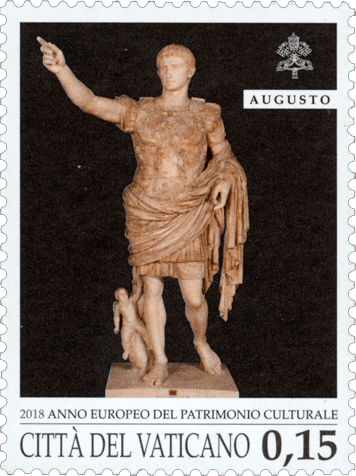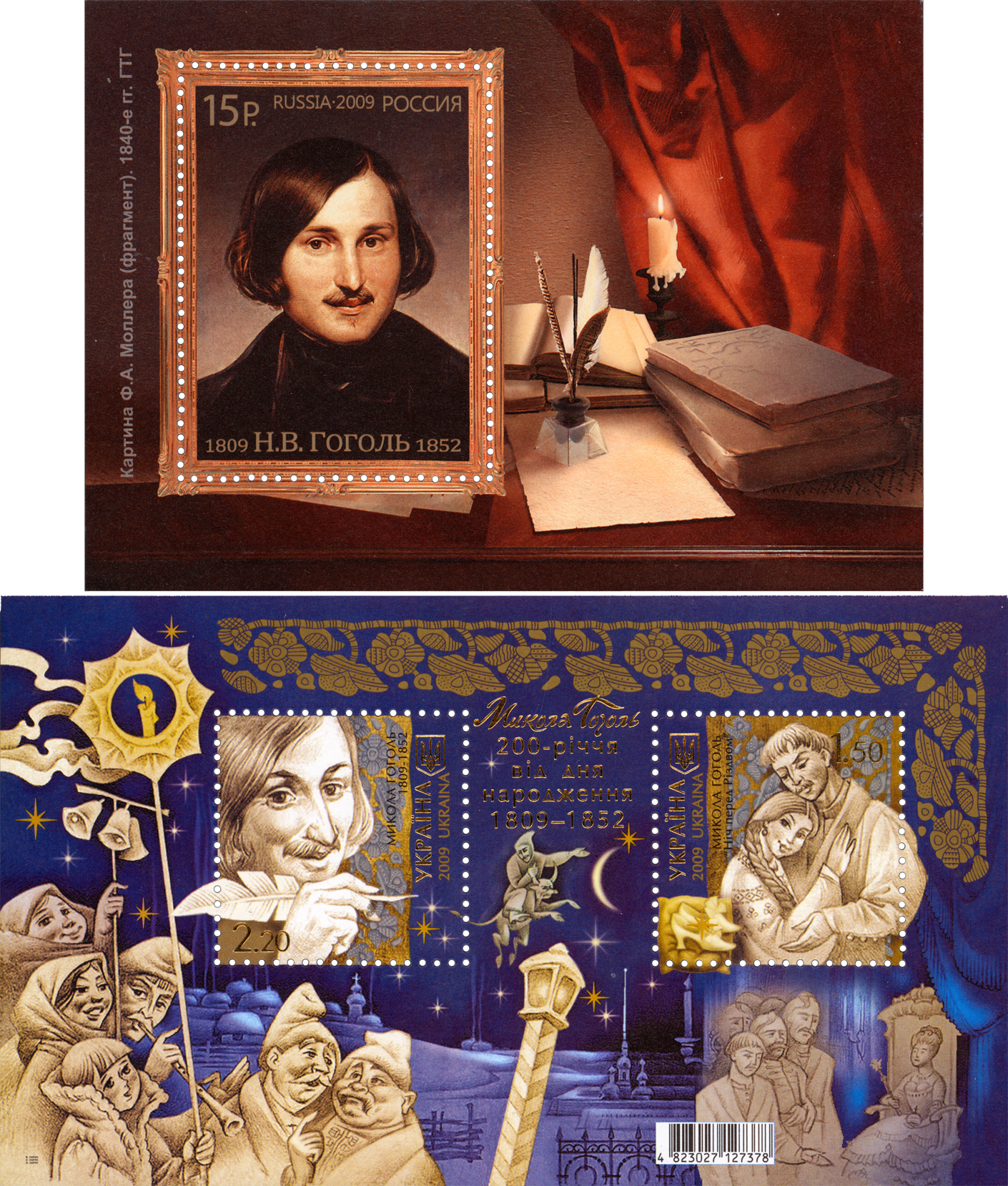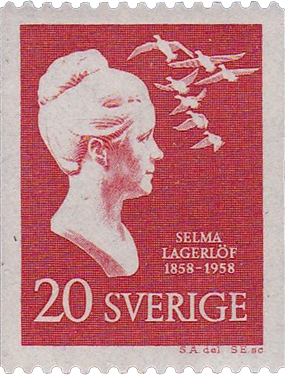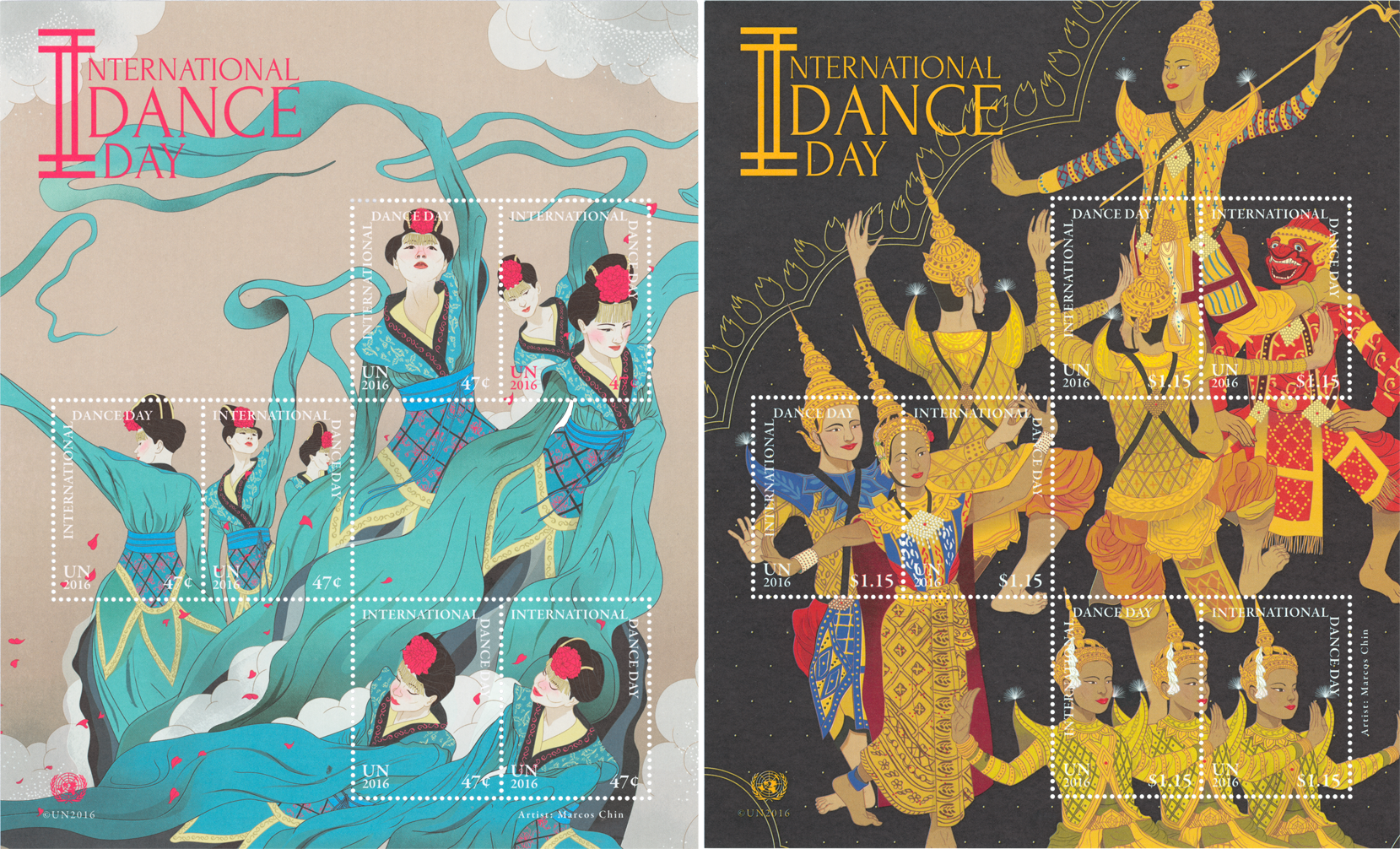LGBTQ Foreign Stamp Gallery
Below is a sampling of the many foreign LGBTQ themed stamps available. Shown are primarily stamps with subject matter that relates to the country of issue. Unless there is no other source, topical issues having themes with no connection to the issuing entity, usually promoted by philatelic agents, are not included here. Otherwise, if your favorite(s) are missing, help add to this page by contacting the webmaster who is listed on the "Contacts Us" page of this website. Either high resolution scans or actual items are acceptible; the latter will be scanned and returned if desired. Be sure to provide a brief description of the subject matter, to include how it relates to a LGBTQ theme.
The sexuality of famous personalities is often open to debate. Even today, many remain in the closet for fear of ruining their career and relationships. For some individuals depicted on the stamps listed below, all we have are clues as their being or possibly being gay, lesbian or bisexual; correspondence that would reveal homosexual relationships was often destroyed after the death of those involved. Also included are some LGBTQ icons. The biographical sketches below are drawn from Wikipedia, Biography.com, Britannica.com, the Gay and Lesbian History on Stamps Journal, the Lambda Philatelic Journal, and various LGBTQ websites.
The topic AIDS on stamps is not explored here. This subject matter is comprehensively covered up to the year 2021 on the AIDS on Stamps website.
George Oprescu
Romania, Scott #2985
George Oprescu (1881-1969) went to Bucharest to attend Matei Basarab High School before studying at the University of Bucharest. He taught French language and literature in Giurgiu and Tumu Severin before becoming associate professor at the University of Cluj. Between 1923 and 1930, he worked in Geneva at the League of Nations, then became chairman of art history at the University of Bucharest. He headed the Toma Stelian Museum and from 1949 until his death, he founded the Romanian Academy's Institute of Art History. In 1959, he was summoned by police investigators looking into his homosexual activity, but Communist authorities refrained from prosecuting him because of his international standing and contacts.
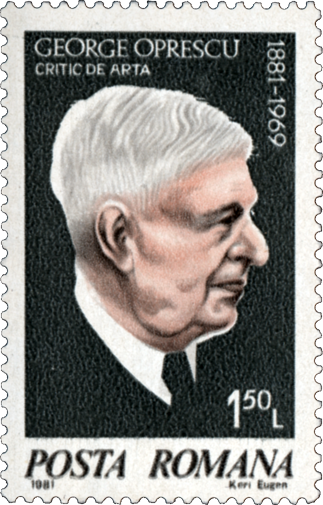
Christian Dior
Romania, Scott #4695
Fashion designer Christian Dior (1905-1957) was born in Granville, Normandy, and grew up in Paris. In 1928, he and Jacques Bonjean opened an art gallery that shuttered in 1931. There, he met intimate friend, Pierre Colle. From 1937, he was employed by fashion designer Robert Piguet until the war. After leaving the army in 1942, he worked at the fashion house of Lucien Lelong. He opened his own fashion house in 1946. His first collection was named the New Look by Carmel Snow, editor-in-chief of Harper's Bazaar. He was a master at creating shapes and silhouettes.
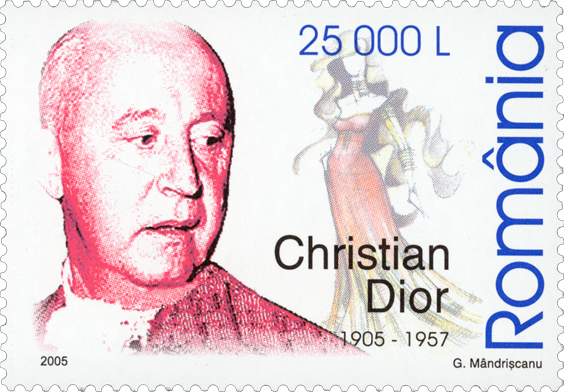
Peter the Great
Russia, Scott #91
Peter the Great (1672-1725) acceded to the throne at the age of ten as co-ruler with an older half-brother Ivan with a half-sister as regent. His mother arranged his marriage to Eudoxia Lopukhina in 1689. Eventually, he became sole ruler at the age of 24. He implemented sweeping reforms, meant to modernize Russia, and brutally suppressed rebellions. He waged war against Sweden and the Ottoman Empire in order to gain access to the Baltic and Black Seas. He founded the city of Saint Petersburg in 1703, intending it to become his new capital. After Peter's favorite, admiral François Le Fort, died in 1699, Alexander Danilovich Menshikov became his favorite for the rest of his life.
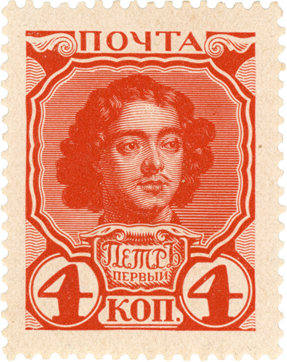
Peter Ilyich Tchaikovsky / Van Cliburn
Russia, Scott #2046
The inaugural Tchaikovsky Piano and Violin Competition was held in 1958, with the upset piano winner being Van Cliburn, then a 23-year old Fort Worth, Texas, native. Composer Pyotr Ilyich Tchaikovsky (1840-1993), whose works are familiar even to those who have no interest in classical music, kept his homosexuality private. He did have a 13-year association with widow Nadezhda von Meck, who was his benefactor despite the pair having never met. He suffered from depression and died early, the cause officially being cholera while others say his death was either accidental or self-inflicted. Like Tchaikovsky, Harvey Lvan "Van" Cliburn (1934-2013) was private about his sexuality, which became public when a palimony suit was filed by his partner of 17 years. Russia has issued numerous stamps over the years honoring Tchaikovsky.
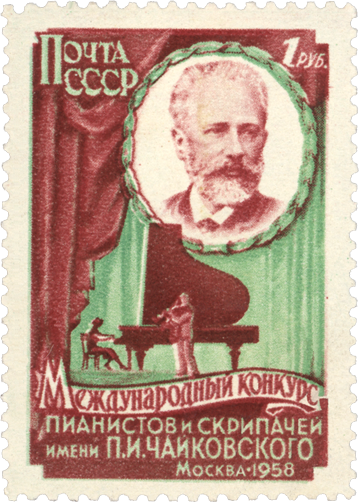
Sergei Yesenin
Russia, Scott #2144, #4369
Lyric poet Sergei Yesenin (1895-1925) was raised by his grandparents in Konstantinovo, Ryazan. He began to write poetry at age nine. In 1912, with a teacher’s diploma, he moved to Moscow. He enrolled in Chanyavsky University, but had to leave after 18 months due to lack of funds. His three-year marriage to Anna Izryadnova began in 1913. He first published a poem in 1914, and in 1915, he moved to St. Petersburg, where he met and lived with intimate friend, Nikolai Klyuev. Sergei's rise to fame was meteoric. He was drafted in 1916, and in the following year, began his four-year marriage to Zinaida Raikh. In 1918, he met and shared a flat with Anatoly Marienhof. They founded the Russian literary movement of imaginism. His less-than-a-year marriage to Isadora Duncan began in 1922. In 1925, he married Sophia Andreyevna Tolstaya, but died less than a year later. His most meaningful love poems are addressed to men, including his suicide poem, Farewell, my friend, farewell.
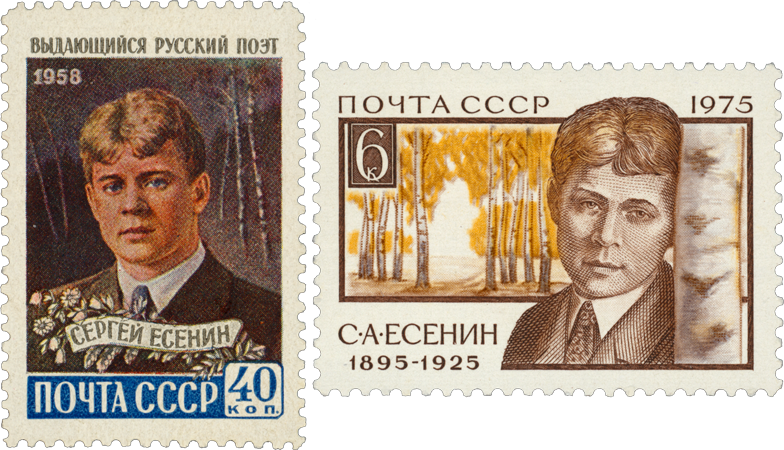
Saadu Shirazi
Russia, Scott #2189
Saadi Shirazi (1210-1291) was a major Persian poet and prose writer of the medieval period. He is widely recognized as one of the greatest poets of the classical literary tradition. Born in Shiraz, he enrolled at the Nizamiyya University in Baghdad. He wandered for 30 years between Iraq and Egypt before returning to Shiraz. His best-known works are Bustan (The Orchard) and Gulistan (The Rose Garden). Both include depictions of Saadi's same-sex, pederastic experiences.
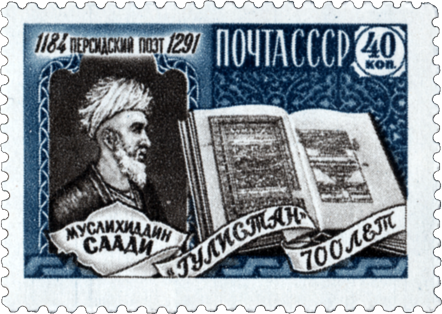
Mikhail Kutuzov
Russia, Scott #2636
Mikhail Kutuzov (1745-1813) was born in Saint Petersburg and had contact with the imperial Romanov family from an early age. He entered an elite military-engineering school in 1757, and after joining the army in 1762, he fought in Poland, and against the Turks in Crimea. He was shot in the head and went to Berlin for care, spending much time with Frederick the Great. He returned to the Russian army in 1776 and was wounded again in 1787. He won considerable distinction in the Russo-Turkish War and was a favorite of Tsar Paul I. He was present at the Battle of Austerlitz before leading Russia in another Russo-Turkish War. Napoleon invaded in 1812, and after the Battle of Smolensk, Mikhail was made commander-in-chief in time to deliver a Pyrrhic victory to Napoleon at the Battle of Bordino. Mikhail was promoted to General Field Marshall, the highest military rank. He abandoned Moscow to the French and waited for their retreat, using the strategy of attrition warfare. Mikhail died in Bunzlau, Silesia, Prussia (now Poland), from a heart attack "said to have resulted from excessive homosexual pleasures with a Russian soldier."
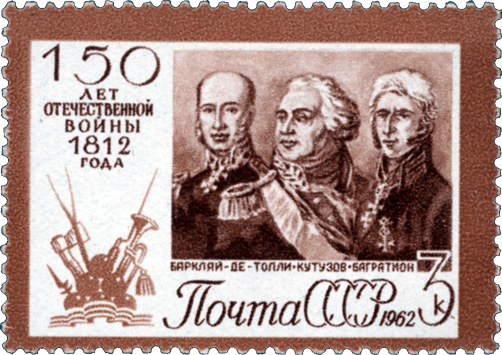
Sergei Eisensteion
Russia, Scott #3095
Born in Riga, Latgia, but Sergei Eisenstein (1898-1948) moved frequently throughout his life. He studied at the Petrograd Institute before joining the Red Army in the Revolution. In Moscow in 1920, he started work in theatre at an experimental Soviet artistic institution. His first film, Glumov's Diary, appeared in 1923. 1925's Battleship Potemkin was critically acclaimed worldwide. Starting in 1928, he toured Europe. Trips to Hollywood and Mexico did not result in completed films, so he was assigned a teaching position at the State Institute of Cinematography. His comeback started with 1938's Alexander Nevsky and continued with Ivan the Terrible, Part I. Sergei likely had a ten-year unrequited relationship with film director Grigori Aleksandrov and professed his asexuality to close friend Marie Seton. He appeared more open in Europe and North America (possibly losing his virginity in Mexico), and U.S. customs discovered homoerotic drawings and photographs in a shipment of his belongings after his Mexico trip.

Georgy Chicherin
Russia, Scott #3959, Scott # to come
Georgy Chicherin (1872-1936) was born into an old noble family in Tambov and graduated from St. Petersburg University before working in the Russian Ministry for Foreign Affairs. He inherited wealth and started supporting revolutionary activities. After the defeat in 1905, he spent the next 13 years in London, Paris, and Berlin. In Imperial Germany, he underwent medical treatment in attempts to cure his homosexuality. In 1917, Leon Trotsky secured Georgy's passage to Russia. He joined the Bolsheviks and was appointed Commissar for Foreign Affairs, pursuing pro-German and, later, pro-China policies under Lenin and Stalin until 1930.
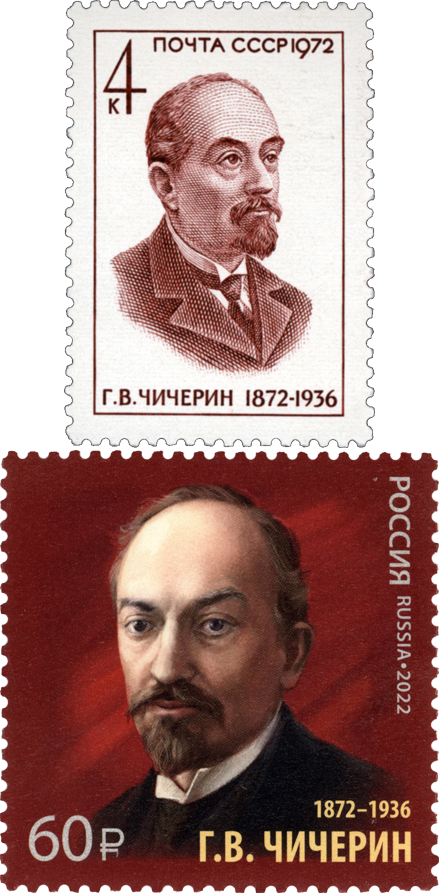
John Reed
Russia, Scott #5611
John Reed (1887-1920) was an American journalist, poet, and communist activist. He was born in Portland, Oregon, and enrolled at Harvard in 1906. After graduation, he started with The American Magazine in New York. Hoping to establish himself as a freelance journalist, his breakthrough arrived with The Saturday Evening Post. In 1913, he joined the staff of The Massed, and the same year, he suffered his first arrest for attempting to speak on behalf of New Jersey silk mills strikers. He shared the perils of Pancho Villa's army to report on the Mexican Revolution and went to Colorado to investigate the Ludlow massacre. He had an affair with Mabel Dodge, and at the beginning of World War I, he travelled Europe, reporting as war correspondent. His book, The War in Eastern Europe, was published in 1916. Later that year, he married Louise Bryant. The following year, the pair travelled to St. Petersburg and witnessed the October Revolution. He went to work for the new People's Commissariat for Foreign Affairs and gave a speech to the Third Congress of Soviets promising to bring the news of the revolution to America. His book, 10 Days that Shook the World, was published in 1919. Indicted for sedition, he fled America for Moscow. He attempted to return but got only as far as Finland. He died of typhus in Moscow. While in New York, he lived in the bohemian Greenwhich Village and associated with some LGBTQ friends, notably Emma Goldman, Frances Perkins, Carl Van Vechten, Charles Demuth and Amy Lowell.
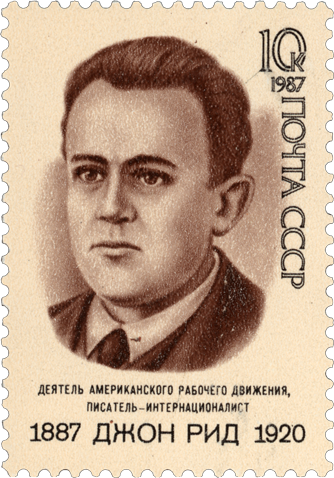
Modest Mussorgsky
Russia, Scott #5754
Born in Karevo, Pskov, Modest Mussorgsky (1839-1881) started piano lessons at age six, and entered the Cadet School of the Guards at age 13. Upon graduation he received a commission with the Preobrazhensky Regiment, the foremost regiment of the Russian Imperial Guard. He became a fixture at composer Alexander Dargomyzhsky's soirées. In 1858, he resigned his commission to devote himself to music while working as a civil servant for income. In 1867, he finished the original orchestral version of Night on Bald Mountain. His opera, Boris Godunov, premiered in 1874. The piano suite, Pictures at an Exhibition, was completed in the same year. Objects of Modest's affections include composer Mily Balakirev, painter Viktor Hartmann, and poet Arseny Golenishchev-Kutuzov. He described his furtive homosexual liaisons, forever "within an ace of discovery, within an inch of love."
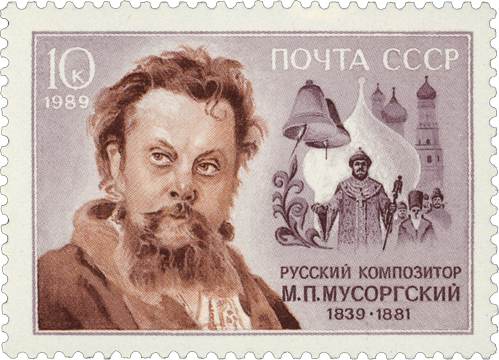
Nikolai Gogol
Russia, Scott #7133; Ukraine Scott #765
Nikolai Gogol (1809-1852) was a dramatist born in Sorochyntsi, Poltava, Ukraine, and from 1820 to 1828, he studied at what is now known as Nizhyn Gogol State University. He moved to St. Petersburg and published his first volume of Ukrainian stories in 1831. He wrote the novel, Taras Bulba, in 1835, and his comedy, The Government Inspector, was first performed the following year. He spent twelve years abroad before returning to publish his novel, Dead Souls, in 1842. It established his reputation as the greatest prose writer in the Russian language. While in Italy, he fell in love with Count Iosif Vielhorsky. (click on image to see a larger one in a new window)
Sergei Diaghilev
Russia, Scott # to come
Sergei Pavlovich Diaghilev (1872-1929), a Russian art critic, patron, ballet impresario and founder of the Ballets Russes, initially studied in Saint Petersburg to become a composer, he was told by Nikolai Rimsky-Korsakov he lacked talent. In the late 1890s, Diaghilev turned to organizing art exhibitions and became involved in the publication of a journal dedicated to the arts and in the Imperial theater. In 1906, Diaghilev emigrated from Russia, and wound up in Paris, France, the world's cultural capital. There he conceived the Ballets Russes, an itinerant company that performed in Europe, and toured North and South America between 1909 and 1929. Considered the most innovative and influential company of the 20th century, Ballets Russes completely reinvigorated the art of performing dance, and introduced its audiences to tales, music, and design motifs drawn from Russian folklore. His most famous lover was dancer Vaslav Nijinsky. After Nijinksky married a woman in 1913, Nijinksy was dismissed from Ballets Russes, though he later returned occasionally. Of Diaghilev's various lovers, only choreographer and dancer Léonide Massine, who replaced Nijinsky, provided him with "so many moments of happiness or anguish."
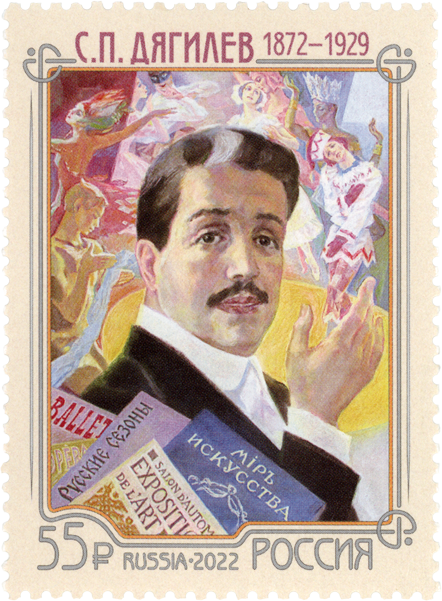
Constantin Somov
Russia, No Scott # for 2019 envelope
Artist Konstantin Somov (1869-1939) studied at the Imperial Academy of Arts in Saint Petersburg under Ilya Repkin from 1888 to 1897. In 1898, he helped found the World of Art artistic group, many of whom were homosexual. He contributed to the World of Art magazine, co-founded the following year by Sergei Diaghilev. Konstantin’s masterpiece was Lady in Blue. He produced several, private homoerotic studies. Writer Mikhail Kuzmin’s diary records a sexual experience that included Konstantin. After the Revolution, he emigrated to the United States, then Paris.
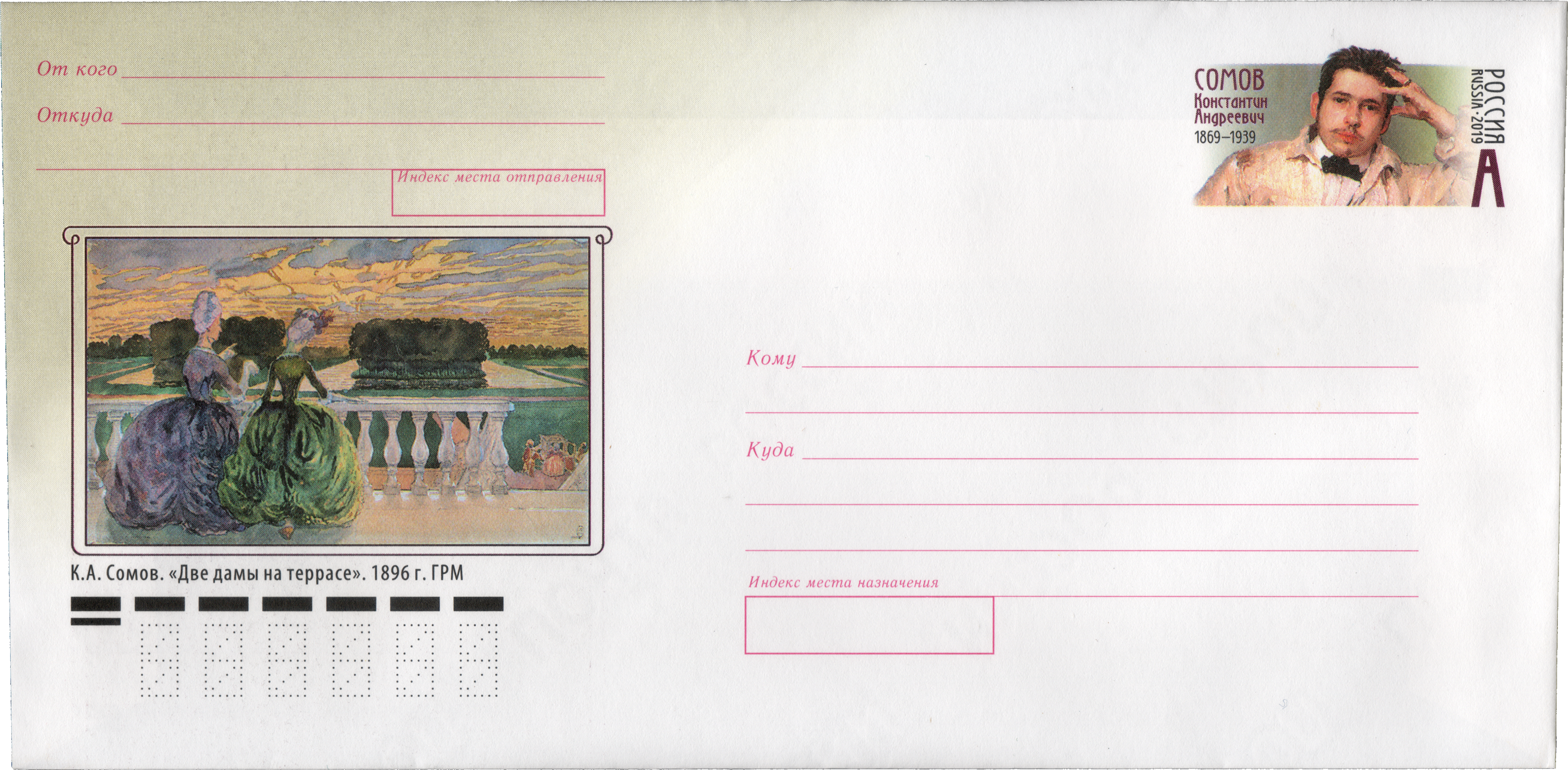
Nikolai Przhevalsky
Russia, No Scott # for envelope
Russian Imperial geographer and renown explorer of Central and East Asia Nikolai Przhevalsky (1839-1888) contributed substantially to European knowledge of Central Asia. He "discovered " Przewalski 's horse, Przewalski 's gazelle, and the Wild Bactrian camel, all of which are now endangered. On each of his expeditions, he was accompanied by a young male lover-companion, one of whom was Pyotr Kozlov.
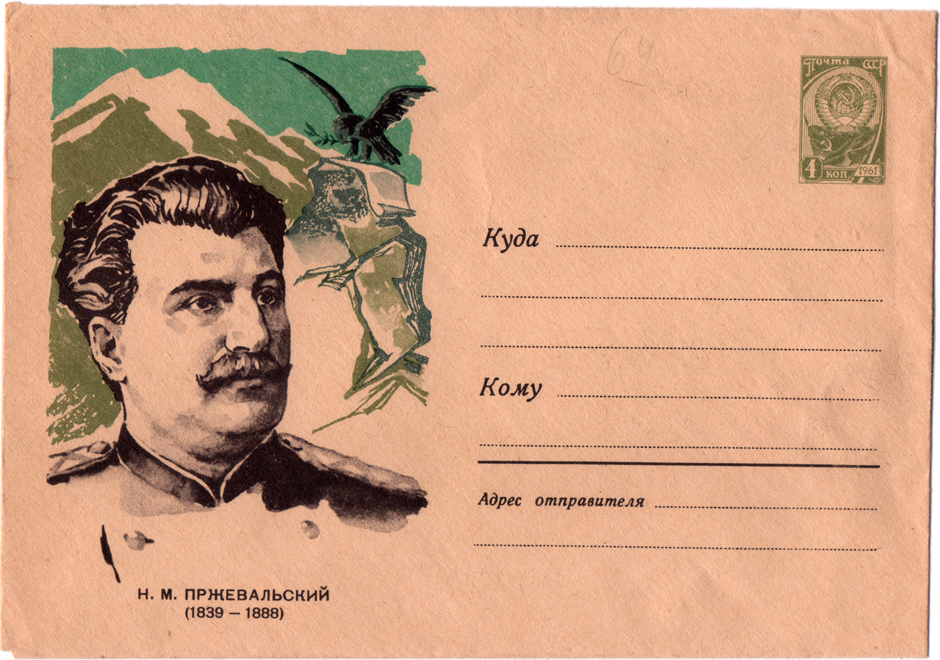
Rudolf Nureyev
San Mariono, Scott #1187-89
Regarded by some as the greatest male ballet dancer of his generation, Rudolf Nureyev (1938-1993) was born on a Trans-Siberian train near Irkutsk and was raised in a Tartar Muslim family. When he saw the ballet, Song of the Cranes, he fell in love with dance. He enrolled at the Vaganova Academy of Russian Ballet in Leningrad in 1955, and upon graduation in 1958, he joined the Kirov Ballet. On June 16, 1961, he defected at Le Bourget Airport in Paris. While on tour in Denmark, he met soloist Erik Bruhn, who became his lover until Erik's death in 1986. Nureyev died from AIDS-related complications in 1993.
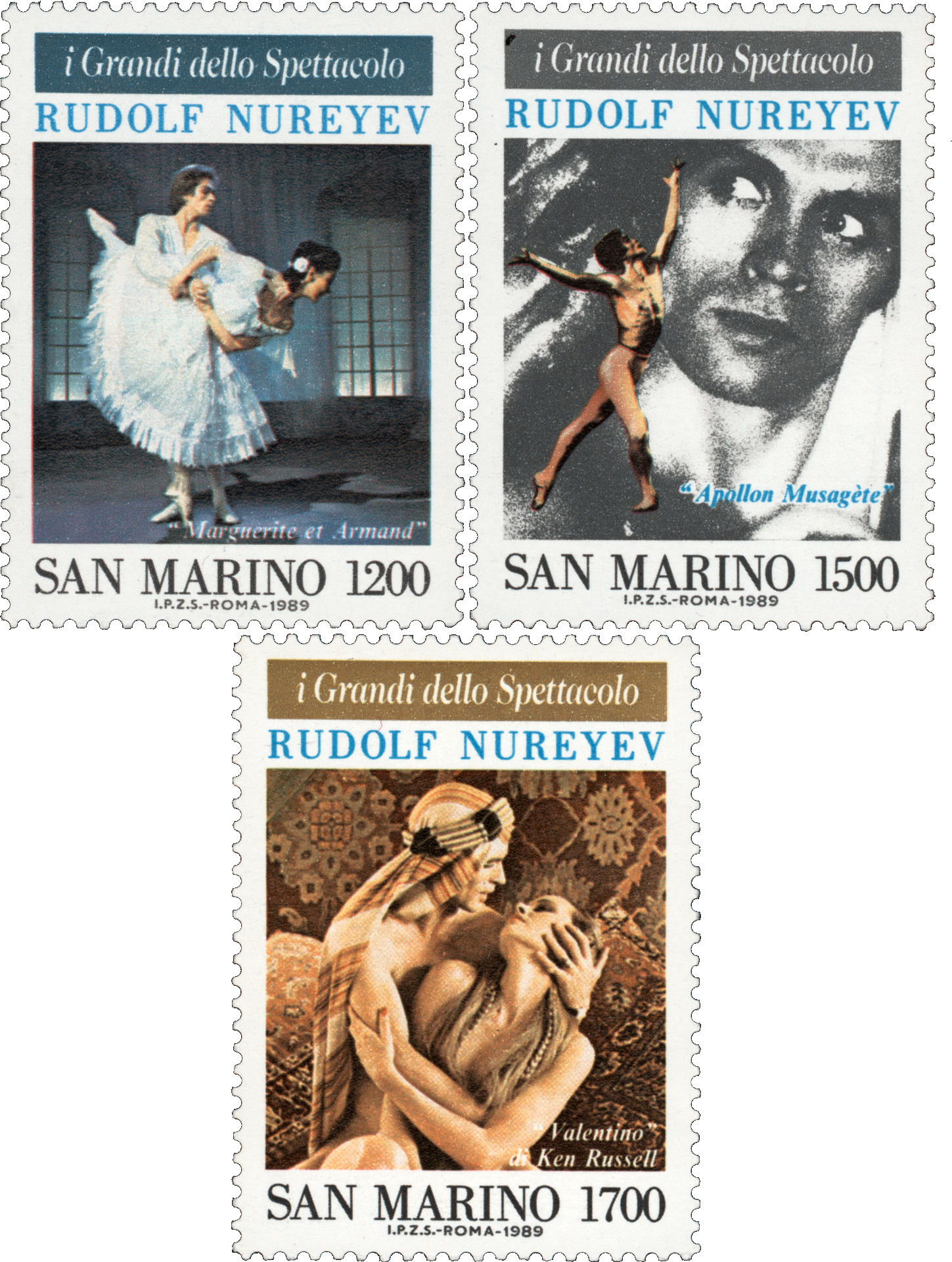
Dragoslav Srejovic
Serbia, Scott #968
Archeologist Dragoslav Srejovic (1931-1996) was one of the very few openly gay public personalities in Serbia. Srejovic's fields of research ranged from paleolithic and mesolithic sites in Yugoslavia, through the late Roman period, to Greco-Roman mythology. A prolific author, he had published more than 200 papers, over 20 monographs and a dozen guides and catalogs. He became a subscribing member of the Serbian Academy of Sciences and Arts in 1974, and a regular member in 1983, and later its vice president.
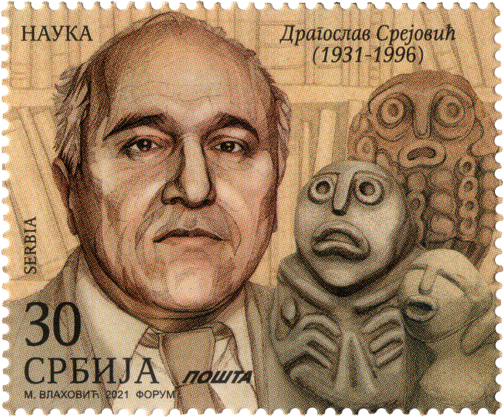
Ondrej Nepela
Slovakia, Scott #289
A native of Bratislava, Czechoslovakia, Ondrej Nepela (1951-1989) met his lifelong coach two weeks after starting to ice skate at the age of seven. He competed at the 1964 Innsbruck and 1968 Grenoble Olympic Games. He was five-time European champion from 1969 to 1973, three-time World champion from 1971 to 1973, and won the gold medal in men's figure skating at the 1972 Sapporo Olympic Games. Skater Toller Cranston, in his autobiography, described a brief 1973 relationship with Ondrej. He toured as a soloist with Holiday on Ice, then moved to Germany and began coaching. He died of complications due to AIDS in 1989.

Jože Plečnik
Slovenia, Scott #480
Architect Jože Plečnik (1872 - 1957) was born in Maribor-Duplek in present-day Slovenia. He studied under noted Viennese architect and educator Otto Wagner and worked in Wagner's architecture office until 1910, after which he moved to Prague. Longing for his hometown, he returned to Ljubljana in 1920, where he reshaped a capital city in ways no other single architect has been able to accomplish. In a letter, a woman-friend asked Plečnik to marry her; he replied, “I am already married to my architecture." Although the Out Adventures website refers to Plečnik as the number five reason to join a 2018 gay tour of Budapest and Slovenia, and he is referred to elsewhere as "most likely homosexual," no concrete evidence has surfaced so far.
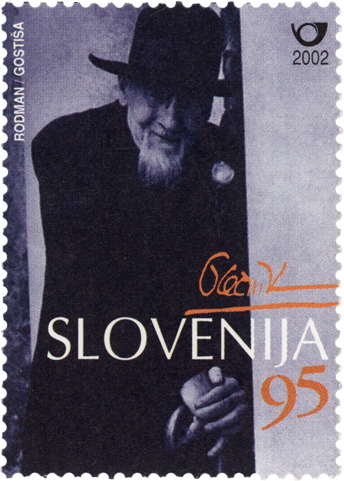
Love
Slovenia, Scott #1427
According to a press release, Slovenia's 2021 entry in its series of Love stamps focuses on "more understanding of different ways of life and relationships that are an inherent part of the society we live in."
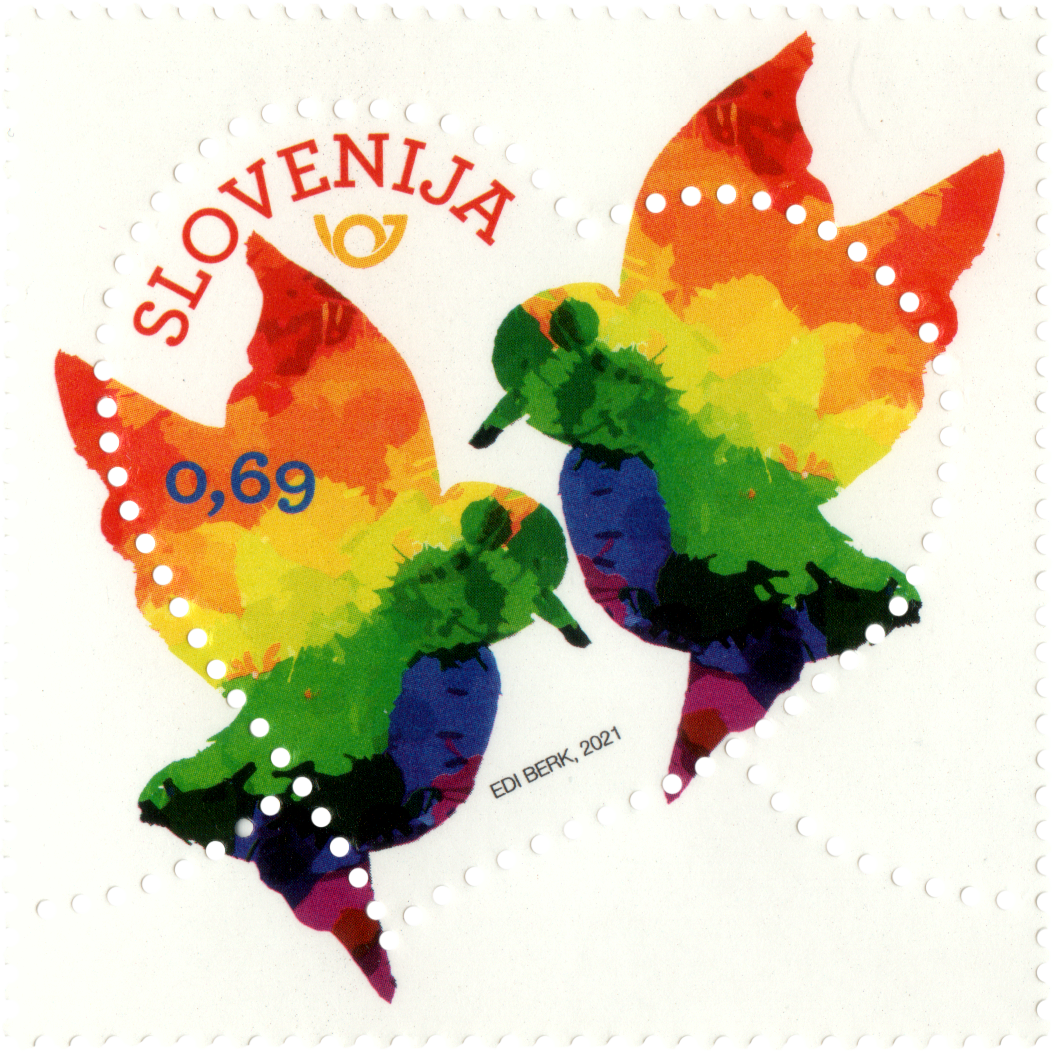
Brenda Fassie
South Africa, Scott #1524a
Brenda Fassie (1964-2004) was South Africa's first black pop star, selling millions of albums during her two-decade career. Her 1998 album, Memeza (Shout), was the first South African album to go platinum on the day of its release. Fassie won three Kora Awards, including one for best female artist, and won five South African Music Awards. Brenda had lesbian relationships with Poppy Sihlahla and Gloria Chaka.
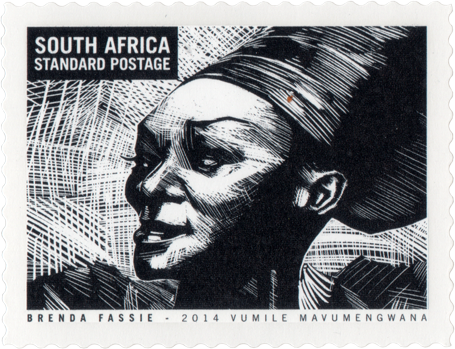
Johnannes Kerkorrel
South Africa, Scott #1524f
Born Ralph John Rabie, singer-songwriter, journalist and playwright Johannes Kerkorrel (1960-2002) first worked as a journalist, but in 1986 began performing anti-apartheid cabaret using his stage name. After being fired from the Rapport newspaper for using quotes in his music apartheid proponent P.W. Botha, he turned to music full time, performing under the name Johannes Kerkorrel en die Gereformeerde Blues Band (Johannes Kerkorrel and the Reformed Blues Band). Their brand of new music was dubbed alternatiewe Afrikaans (alternative Afrikaans) and exposed divergent political views to a new generation of Afrikaners. In the 1990s, he spent considerable time performing in Belgium and Netherlands. Beset by financial problems and finding no work, the hanged himself in a forest near Kleinmond, Western Cape province. Besides a son and ex-wife, he was suivived by his long-time partner Demetrios Demetriou.
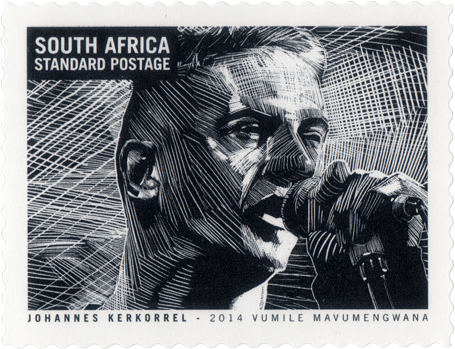
Cecil Rhodes
Southern Rhodesia, Scott #58
Cecil Rhodes (1853-1902) was born in Bishop's Stortford, Hertfordshire, and was sent to South Africa at the age of 17 in the hope that the climate would improve his health. He entered the diamond trade at Kimberley, and over the next two decades he gained near complete domination of the world diamond market. His diamond company, De Beers, was founded in 1888. He entered the Cape Parliament in 1881 and served as Prime Minister of the Cape Colony from 1890 to 1896. He founded the territory of Rhodesia (now Zimbabwe and Zambia) in 1895. Cecil was in love with his private secretary, Neville Pickering, who died in his arms. He had relationships with Harry Latham Currey, John/Johnny/Jack Grimmer, and Philip Jourdan. His last will provided for the establishment of the prestigious international Rhodes Scholarship at Oxford University.
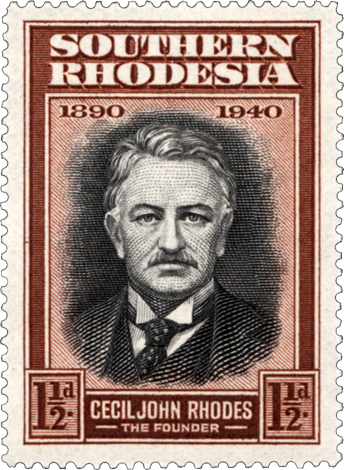
Jacinto Benavente
Spain, Scott #1387
One of the foremost Spanish dramatists of the 20th century, Jacinto Benavente (1866-1954) was born in Madrid and was elected to the Spanish Royal Academy in 1912. He was awarded the Nobel Prize in Literature in 1922. In the late 1940s, he was blacklisted by the Franco government, possibly because of his homosexuality: his name could not appear in Spanish press. His plays, however, were not banned. He wrote 172 works. He never married and according to many sources, he was homosexual.
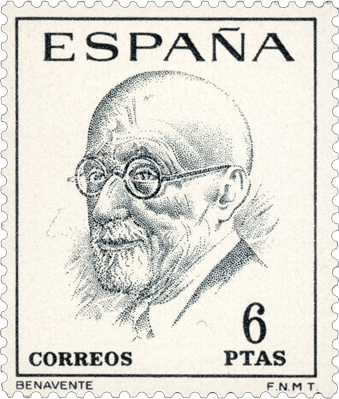
Galba
Spain, Scott #1531
Galba (3 B.C. – 69 A.D.) was Emperor of Rome from 68 to 69, the first in the Year of the Four Emperors. He was born near Terracina in Latina, southeast of Rome. He had a sexual appetite for males, whom he preferred over females, though he married Aemilia Lepida, who died during the early years of the reign of Claudius. He was praetor, consul, and governor of Aquitania, Upper Germany, and Africa before briefly retiring. He became governor of Hispania and seized the throne after Nero’s suicide.

Manuel de Falla
Spain, Scott #2019
Born in Cádiz, Spain, Manuel de Falla (1876-1946) started piano lessons early. In Madrid, he attended the Real Conservatorio de Música y Declamación where he premiered his first composed works. He moved to Paris in 1907, where it is believed he was involved in a love triangle with composer Maurice Ravel and pianist Ricardo Viñes. After the beginning of World War I, he returned to Madrid, then moved to Granada, where his home became a celebrated meeting place for Spanish gay intellectuals and artists. After Franco's victory in the Spanish Civil War, Manuel moved to Argentina.

Vicente Aleixandre
Spain, Scott #2447
Vicente Aleixandre (1898-1984) received the Nobel Prize in Literature in 1977 "for a creative poetic writing which illuminates man's condition in the cosmos and in present-day society, at the same time representing the great renewal of the traditions of Spanish poetry between the wars." He was born in Seville and was part of the Generation of &'27. His bisexuality was well known to his circle of friends, and he had a long-term love relationship with poet Carlos Bousoño.
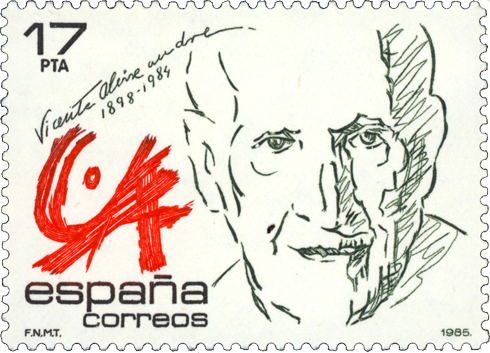
Fredrico Garcia Lorca
Spain, Scott #2946; Mexico, Scott #2078
Federico del Sagrado Corazón de Jesús García Lorca (1898-1936) was a Spanish poet, playwright, and theater director. He left his native Granada in 1919 for Madrid to study music, but turned to writing poetry and plays, achieving international recognition as a member of the Generation of ' 27, a group of mostly Spanish poets. By 1929 he was in New York, publishing a collection Poet in New York. Returning to Spain in 1930, he directed theater for the new Republic government and by the mid-1930s produced his greatest works, the trilogy Blood Wedding, Yerma and The House of Bernard Alba. The Spanish civil war broke out in July, 1936 when conservative generals rose against the leftist Republican government. Lorca was executed the following month, probably due to his Republican sympathies. His body or bones have never been found. A Franco-era report dated July 9, 1965, described the writer as a "socialist" and "freemason belonging to the Alhambra lodge," who engaged in "homosexual and abnormal practices."
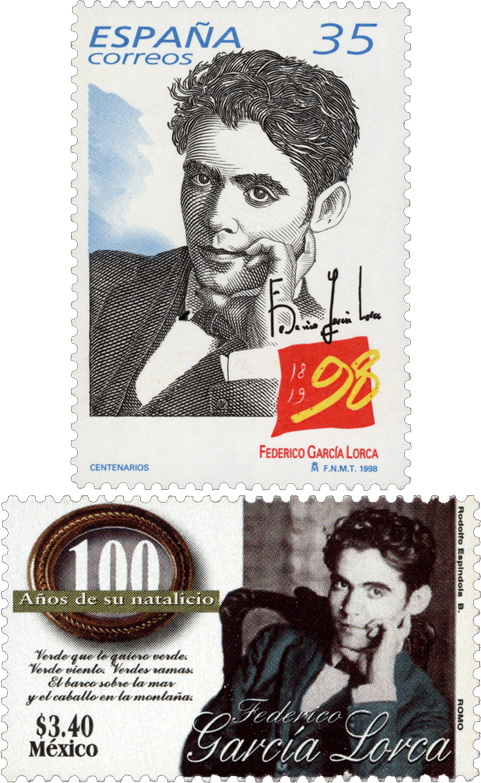
Luis Cernuda
Spain, Scott #3163
Luis Cernuda (1902-1963) was born in Seville, Spain, and graduated from the University of Seville with a law degree. In 1927 he moved to Madrid and met other young writers, including Federico García Lorca and Vicente Aleixandre, and his poems were read in homage to the great Spanish poet Luis de Góngora. Because of these homages, the group of young poets became known as the Generation of 1927. After reading Louis Aragon and other French writers and recognizing the social stigma attached to his homosexuality, he was drawn toward surrealism. It would allow him to express himself more freely in his books Un río, un amor (A River, A Love) (1929) and Los placers prohibidos (Forbidden Pleasures) (1931). Abandoning surrealism, his most famous book, La realidad y el deseo (Reality and Desire) was published in April 1936. Fleeing the Civil War, Cernuda taught at the University of Glasgow and the University of Cambridge before lecturing at Mount Holyoke College, Massachusetts, the National Autonomous University of Mexico, and at UCLA.
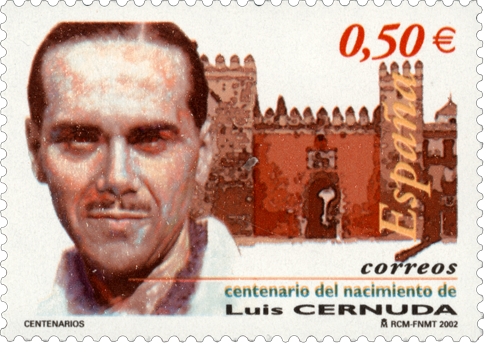
Gonzalo Fernández de Córdoba
Spain, Scott #4094
Gonzalo Fernández de Córdoba (1453-1515) was a Spanish general and statesman who led successful campaigns during the Conquest of Granada and the Italian Wars. He was born at Montilla, Córdoba, and he fought for Isabella during the civil war over her accession. He married Mara de Sotomayor in 1474 and María Manrique de Lara y Figueroa in 1489. Córdoba revolutionized military strategy by integrating firearms into the Spanish infantry and directed the first battle in history won by gunpowder small arms, the Battle of Cerignola in 1503. Various sources from the 16th century cite his homosexuality.
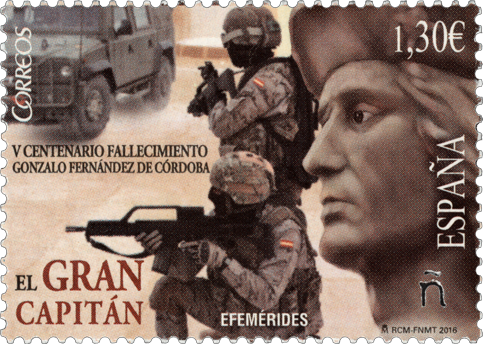
Mariano Eusebio Gonzáles García, aka Luis Mariano
Spain, Scott #4156b
Mariano Eusebio Gonzáles García (1914-1970), better known as Luis Mariano, was a popular Spanish singer in both Spain and France. His family fled from Spain to Bordeaux, France at the start of the Spanish Civil War. He took up singing and sang in numerous stage shows and became known as the "King of Operetta". In 1943, he appeared in his first major film. Never married, Mariano's family and avid fans deny he was gay; several biographers have come to a different conclusion.
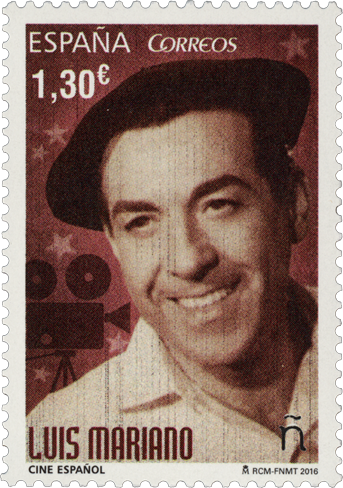
Trajan
Spain, Scott #4233
Trajan (53-117) was Roman emperor from 98 to 117. He is remembered as a successful soldier-emperor who presided over the second greatest (after Augustus) military expansion in Roman history. He is also known for his philanthropic rule, overseeing extensive public building programs and implementing social welfare prolicies. His putative lovers include Hadrian, pages of the imperial household, the actor Pylades, a dancer called Apolaustus, and senator Lucius Licinius Sura.
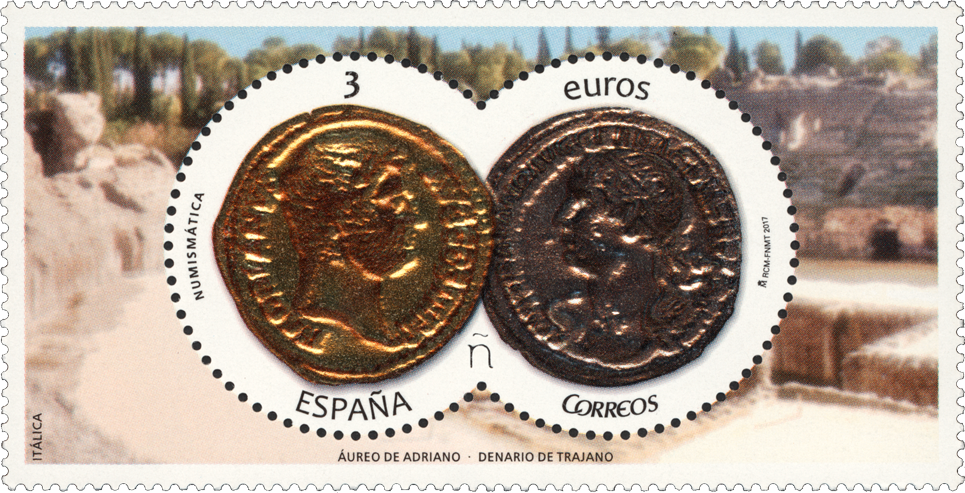
Gloria Fuentes
Spain, Scott #4283
Gloria Fuertes García (1917-1998) was a Spanish poet, short story writer, playwright and author of children's literature. She is linked to the first Spanish literary movement after the Civil War, 1950's Generation or postism. She worked in children's magazines in the 1940s and 1950s, and she was co-founder of "Verses in Skirts," a group that organized concerts and poetry readings in bars and cafes. One of her most known works is Three Wise Queens: Melchora, Gaspara y Baltasara, published in 1978 and now a children's literature classic in Spain. She became better known in the 1970s, after her collaborations on Spanish children's television shows. Academic sources indicate she was a a pacifist lesbian, defending equality between men and women, and fighting for the environment.
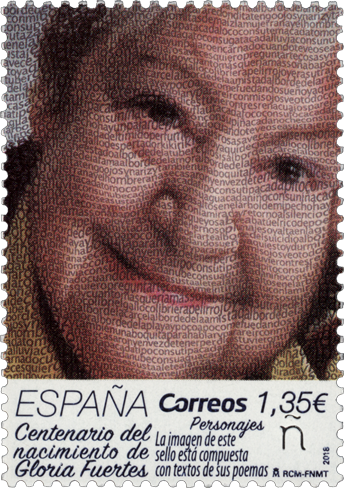
Millennial Generation
Spain, Scott #4379
A souvenir sheet issued September 19, 2019 notes milestones for the millennial generation. In addition to the three stamps contained therein, in small print on the right side of the souvenir sheet are other topics such as the introduction of the Euro currency, the I-phone and the "approval of same-sex marriage in Spain (2004)." The law became effective July 3, 2005. (click on image to see the small print clearly)
Rainbow Flag
Spain, Scott #4447
Spain's 2020 rainbow flag stamp commemorates the Pasaje Begoña, an alley in Torremolinos, a beach town on the Costa del Sol where the country' first gay bar opened in 1962. By 1971, the alley had become an epicenter of a thriving gay scene in conservative Spain, then ruled by the oppressive dictator, Gen. Francisco Franco. On June 24, of that year, a massive police raid resulted in as many as 400 persons being arrested and fined astronomical amounts. As many of those arrested were tourists, the raid brought international condemnation. Decades passed before Torremolinos regained popularity as a tourist destination. The last line on the stamp translates "Cradle of Gay Rights".
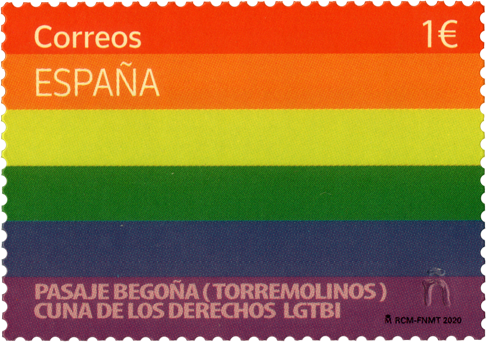
Selma Lagerlöf
Sweden, Scott #532-34
Selma Lagerlöf (1858-1940) was the first female writer to win the Nobel Prize in Literature. She was constantly writing poetry as a child and was educated at the Royal Seminary in Stockholm. She taught school for ten years before meeting her companion, Sophie Elkan. One of her most popular books, The Wonderful Adventures of Nils, was published in 1902. (click on image to see entire set of three)
Greta Garbo
Sweden, Scott #1386c, #2517
Swedish-American actress Greta Lovisa Gustafsson (1905-1990), who adopted the stage name Greta Garbo, was popular in the 1920s and 1930s, earning three Oscar® nominations during that time. Her later films faltered, prompting her to retire from the screen after 1941. She had many love affairs throughout her life. She thrilled audiences dressed in men's tuxedos, and wearing pants before it was the style. Both men and women flocked to Garbo's movies. Garbo is quoted as saying: "I could not choose between love for a man or love for a woman ... I became a slave to both sexes ... I was equally fascinated by both female and male bodies." For the centennial of her birth in 2005, the U.S. issued a stamp almost identical to one in the pair shown here.
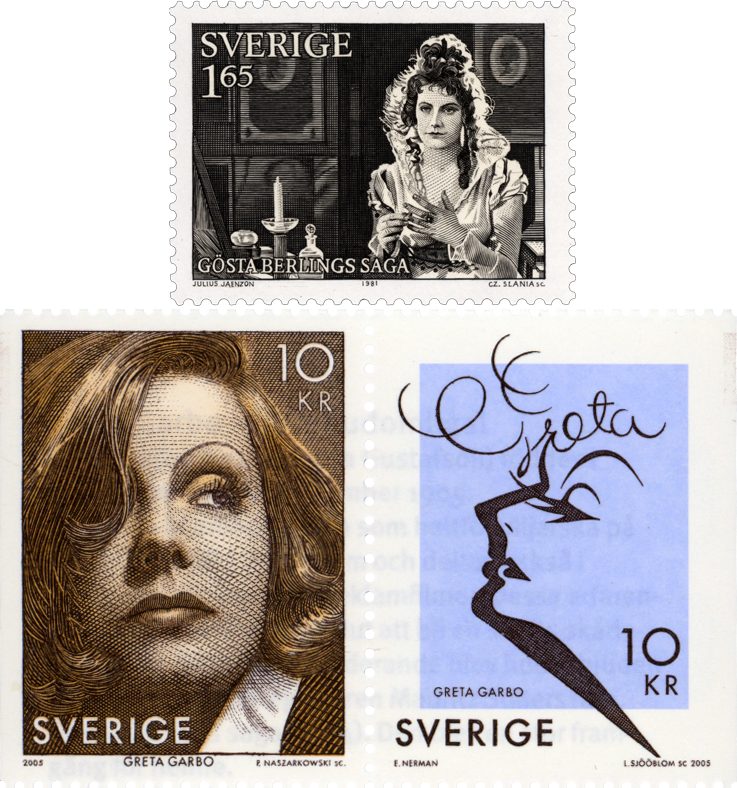
King Gustav III of Sweden
Sweden, Scott #2069
Gustav III (1746-1792) was King of Sweden from 1771 until his assassination in 1792. He was born in Stockholm, and he grew precociously experienced in the art of dissimulation. He married Danish Princess Sophia Magdalena in 1766, and for consummation, his parents requested actual physical instruction, reportedly because of anatomical problems of both spouses. Gustav had relationships with courtiers Axel von Fersen the Younger, Gustav Mauritz Armfelt, and Johan Fredrik Aminoff. He travelled to Paris and visited his uncle, Frederick the Great, before accession. After he quelled a coup d'état, he delivered his famous philippic, viewed as one of the masterpieces of Swedish oratory. Enthusiastic for the ideas of the French enlightenment, he worked towards reform. As a prelude to obtaining Norway from Denmark, he first conducted the Russo-Swedish War, which included the greatest naval victory ever achieved by the Swedish Navy. The war and his abolishment of the old privileges of the nobility led to his assassination at a masked ball at the Royal Opera House in Stockholm.
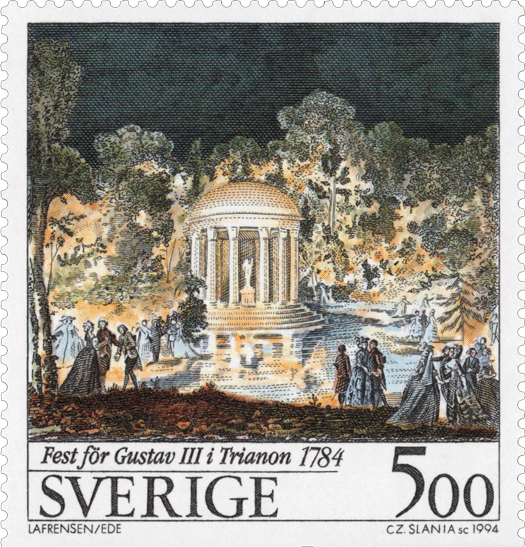
Rikard Wolff
Sweden, Scott #2141
Jan Rikard Wolff (1958-2017) was a Swedish stage and screen actor and singer. His career included film roles in House of Angels (1992) and its two sequels. He was openly gay and in those movies played the gay sidekick of a granddaughter who inherits a mansion in a small community that is divided by their presence. A scene from the movie appears on a 1995 Swedish motion picture centennial stamp.
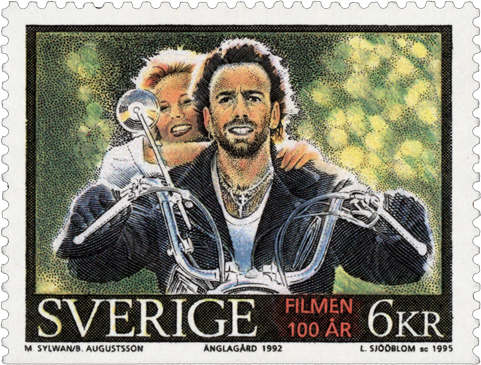
Christina
Sweden, Scott #2774
Christina (1626-1689) became Queen of Sweden at the age of almost six. She is remembered as one of the most learned women of the 17th century. Before her father died in the Thirty Years’ War, he secured that Christina should receive an education of the type normally afforded only to boys. She learned at least seven languages besides Swedish. Her closest female friend was Ebba Sparre, with whom she shared a bed. In 1645, she founded Ordinari Post Tijdender, the oldest currently published newspaper in the world. In 1649, Christina announced that she had decided not to marry. She suffered a nervous breakdown in 1651, and in 1654 she abdicated her throne, probably because she planned to become Roman Catholic and because she had become unpopular. She left the country dressed in men's clothes, eventually settling in Rome. She wrote passionate letters to Ebba Sparre, and while visiting Paris, ladies were shocked by her masculine appearance and demeanor. Near the end of her life, she wrote that she was "neither Male nor Hermaphrodite, as some People in the world have pass'd me for."
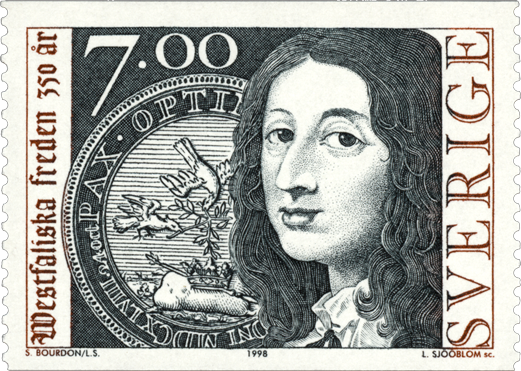
Eva Dahlgren
Sweden, Scott #2493c
Eva Dahlgren (born 1960) is a Swedish pop musician. Her debut album was released in 1978. Her breakthrough in Sweden came in 1991 with the hit album En blekt blondins hjärta. She married jewelry designer Efva Attling in 2009.
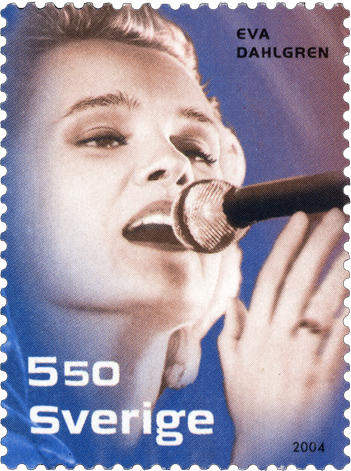
Sweden Rainbow Flag
Sweden, Scott #2274
The rainbow flag made a full-face philatelic debut on this 2016 Swedish stamp. According to the news release announcing the stamp, more than 30 localities had pride events the prior year. However, the first purposeful depiction of the rainbow flag occurred three years earlier, on a stamp from Uruguay. PostNord, jointly owned by the Swedish and Danish governments, issued two pride stamps (Scott #1770-71) for Denmark the following year.
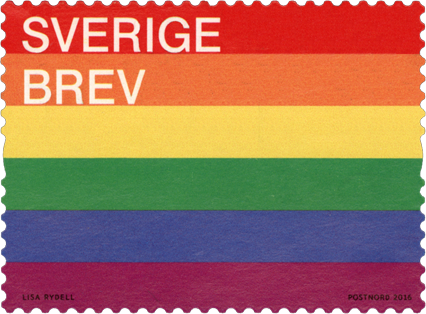
Diversity
Switzerland, Scott #1743
In 2019, Liechtenstein and Switzerland jointly issued four stamps commemorating Social Diversity, including two stamps featuring Throng, by Luigi Olivadoti, which appears to depict a Pride gathering with a Rainbow Flag, created by Gilbert Baker.
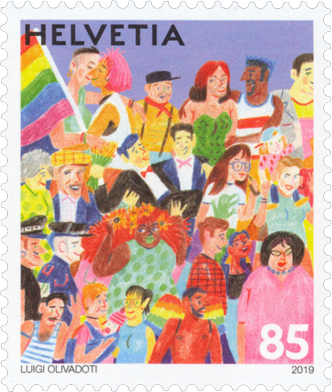
Mustafa Kemal Atatürk
Turkey, Scott #631, #645, #1122, #1270, #1883, #2139, #2541
A founding father of modern day Turkey, Mustafa Kemal Atatürk (c. 1881-1938) was born in Salonica, Ottoman Empire, (now Thessaloniki, Greece) and graduated from the Ottoman Military College in Constantinople in 1905. He fought in the Italio-Turkish War, the Balkan Wars, World War I, and the Turkish War of Independence, rising to the rank of field marshal. He served as Turkey's first president from 1923 until his death, undertaking sweeping progressive reforms which modernized Turkey into a secular, industrial nation. Atatürk married Latife Uşakligil in 1923. The circumstances of the 1925 divorce and Latife's diaries and correspondence remain closely guarded secrets in Turkey. Several biographers mention his attraction to and affairs with males in addition to his involvement with women. His image has appeared on hundreds of Turkish stamps since 1924, especially definitive and official issues, so only a few are shown here. Insulting his memory is a crime in Turkey, so his sexuality should not be discussed when visiting the country.
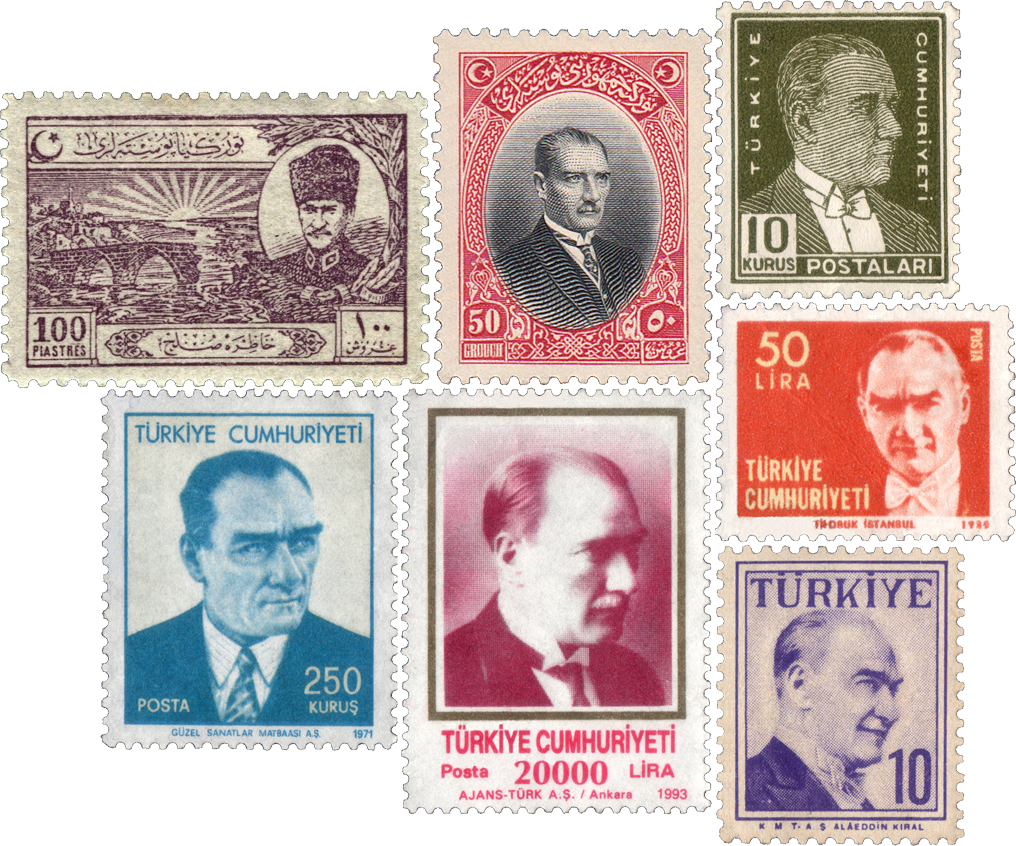
Glaucus
Turks & Caicos Islands, Scott #1193a
In Greek mythology, Glaucus was a Greek prophetic sea-god, born mortal and turned immortal upon eating a magical herb. In addition to falling in love with Scylla and Ariadne, he was reported to have had male lovers, including Nereus and Melicertes.
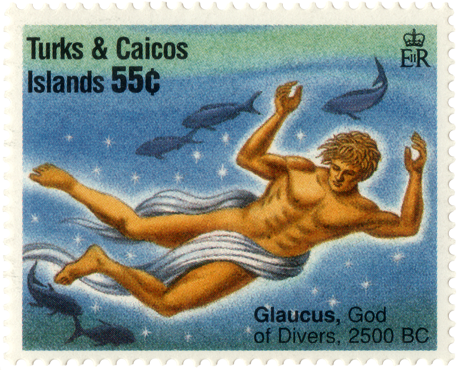
Gertrude Stein
Uganda, Scott #1186
Gertrude Stein (1874-1946) was born in Pittsburgh, Pennsylvania, and raised in Oakland, California. She graduated from Radcliffe College in 1898 and studied at Johns Hopkins School of Medicine before moving to Paris in 1903. Until 1938, she hosted a salon at 27 rue de Fleurus where leading figures of modernism in literature and art met. She met her life partner, Alice B. Toklas in 1901. Her 1933 quasi-memoir, The Autobiography of Alice B. Toklas, became a literary bestseller. During World War II, she collaborated with Vichy France, translating speeches of Marshal Philippe Pétain.p>
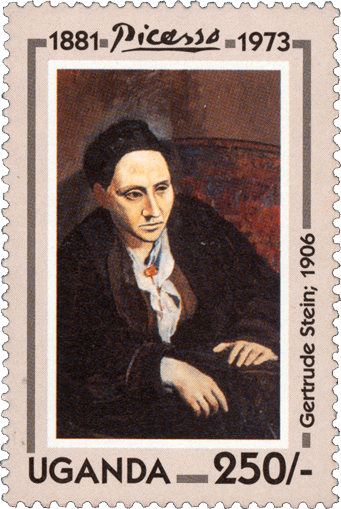
Saints Sergius and Bacchus
Ukraine, Scott #434c
Saints Sergius (or Serge) and Bacchus were early fourth-century Roman Christian soldiers revered as martyrs and military saints by the Catholic, Eastern Orthodox and Oriental Orthodox Churches. According to the Greek text known as The Passion of Sergius and Bacchus, their covert Christianity was discovered when they attempted to avoid accompanying a Roman official into a pagan temple. Refusing to sacrifice to Jupiter, they were publicly humiliated by being chained, dressed in female attire and paraded around town. They were sent to Barbalissos in Mesopotamia to be tried by Antiochus, the military commander there and an old friend of Sergius. Antiochus could not convince them to give up their faith, however, and Bacchus was beaten to death. The next day Bacchusֺ spirit appeared to Sergius and encouraged him to remain strong so they could be together forever. Over the next days, Sergius was also brutally tortured and finally executed at Resafa, where his death was marked by miraculous happenings. Although most historians reject the theory their relationship was a romantic one, the possibility has led to popular veneration of Sergius and Bacchus in the gay Christian community.
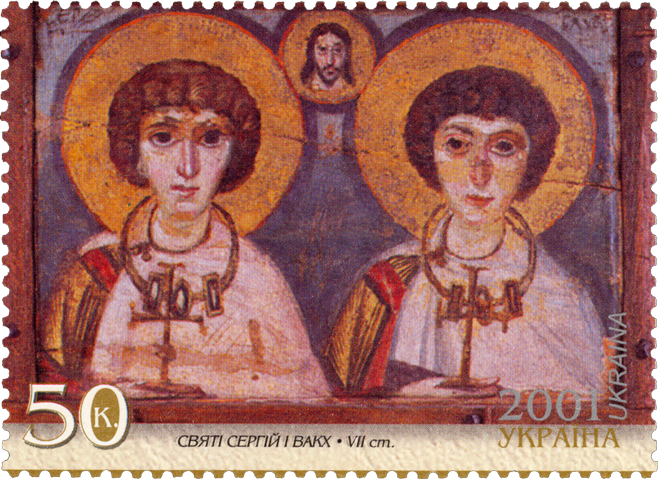
Universal Declaration of Human Rights
UN-New York Scott #13-14
The Universal Declaration of Human Rights was adopted by the United Nations General Assembly on December 10, 1948. Its 30 articles enshrine the rights and freedoms of all human beings. It was adopted as a "common standard of achievement for all peoples and all nations." Article 2 says, "Everyone is entitled to all the rights and freedoms set forth in this Declaration, without distinction of any kind.". U.N. stamps have been issued on various anniversaries of the declaration, the first in 1952 (shown here) and the latest in 2018.
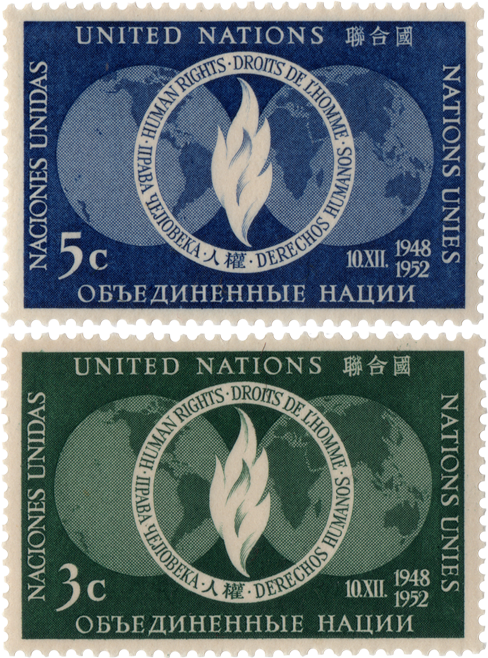
Free and Equal
UN-NY Scott #1127-28; UN-Geneva Scott #613-14; UN-Vienna Scott #579-80
In 2016, the United Nations issued six stamps, two for each of its main offices in New York, Geneva and Vienna, to publicize its Free and Equal campaign to stand up for equal rights and fair treatment for lesbian, gay, bisexual, transgender and intersex people. The stamps were designed by out artist Sergio E. Baradat, a graphic designer of Cuban descent who often creates works in the style popular in the first half of the 20th century; he is currently the U.N. Postal Administration's art director. Baradat has also designed several United States stamp issues.
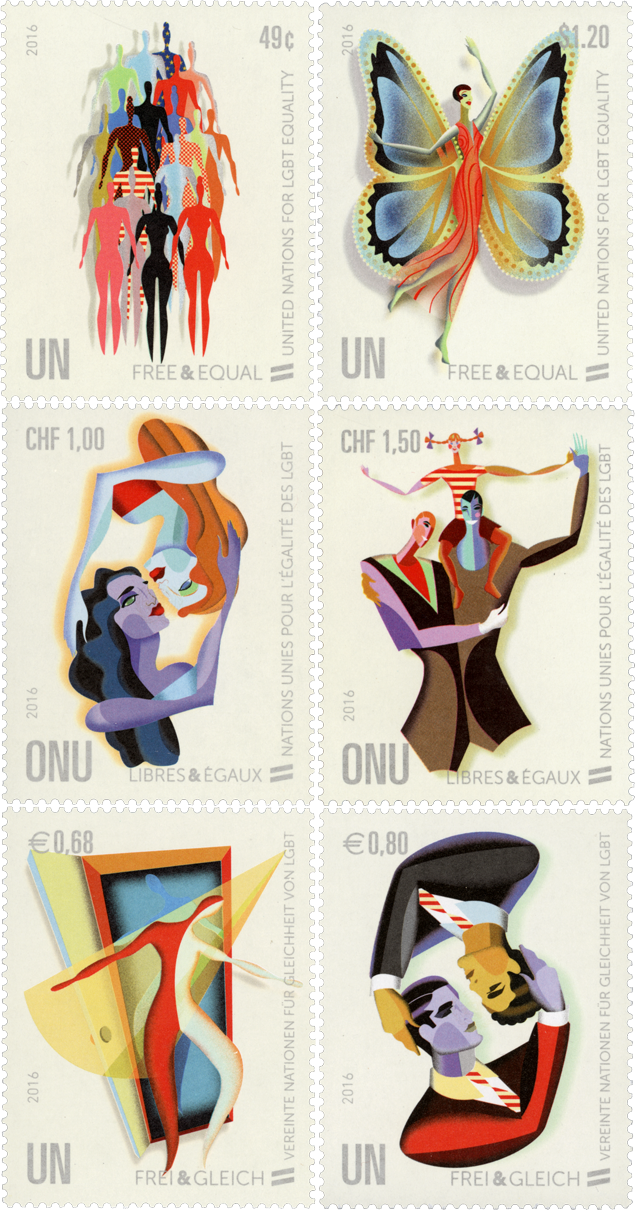
Marcos Chin
United Nations, Scott #1132-33
Marcos Chin is an openly gay, award-winning illustrator. He was born in Mozambique, but his family emigrated in the mid-1970s due to civil war. After spending some time in Portugal, they eventually wound up in Toronto, Canada, where he grew up and spent much of his life. He said he didn't come from an artistic family but always liked to draw, so he went to art college and chose the path of illustration. His illustrations were widely praised and he currently teaches at New York’s School of Visual Arts. (click on image to see a larger version in a new window)
Coalition of Cities Against Racism, Discrimination and Xenophobia
Uruguay, Scott #2242 booklet cover
One of the four arms is rainbow colored on a 2008 booklet cover for The Latin American and Caribbean Coalition of Cities Against Racism, Discrimination and Xenophobia.

Campaign Against Discrimination
Uruguay, Scott #2456
One of the most socially liberal states of South America, Uruguay issued in 2013 a "Campaign Against Discrimination" stamp reproducing Eugéne Delacroix's painting Liberty Leading the People, with the rainbow flag replacing the French one. This is the first purposeful depiction of the rainbow flag on a postage stamp. The stamp, a part of the AMERICA series, appeared in approximately 6,000 numbered sheets of eight. See the related stamp from Cuba.
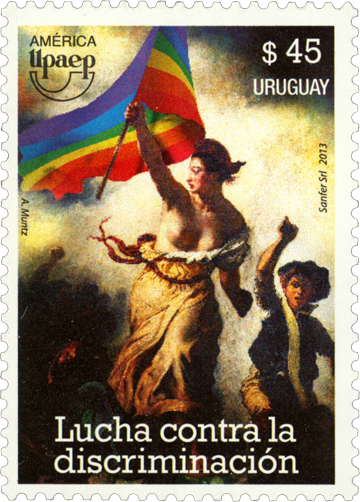
Angela Davis
Uruguay, Scott #2661
Angela Davis (born 1944) graduated from Brandeis University, University of California at San Diego, and Humboldt University (East Berlin), and is professor emerita at University of California at Santa Cruz. She worked with the Black Panther Party during the civil rights movement. She was a member of the Communist Party until 1991 and was twice their candidate for vice president of the United States. She is an accomplished writer, lecturer/speaker, and political activist. She identified as lesbian in 1997 in Out magazine.
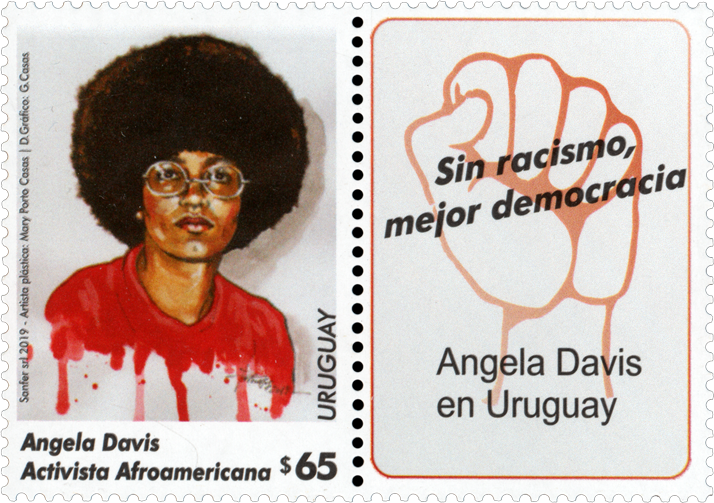
Stephaía
Uruguay, Scott #2734e
Stephaía is the subject of the 2015 film, El hombre Nuevo (The New Man), directed by Aldo Garay. At the age of twelve, as Roberto, she supported the Sandinista revolution in Nicaragua and fought for education and social reforms. She fought alongside the communist Tupamaros in Uruguay. Thirty years later, she struggles to live as Stephanía, striving to be accepted by both society and family.
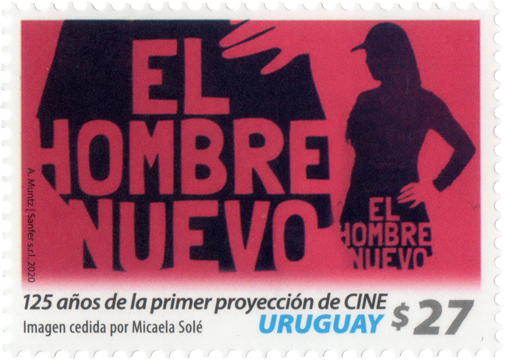
Comte de Lautréamont
Uruguay, Scott # to come
The son of a French consular officer, Isidore Lucien Ducasse (1846-1870) was born in Montevideo, Uruguay. His nome de plume was Comte de Lautréamont. At the age of 13, he was sent to France to continue his schooling. After graduation from Lycée Louis Barthou in Pau, Ducasse lived in Tarbes, where he started a homosexual relationship with Georges Dazet, the son of his guardian, and decided to become a writer. He briefly returned to Montevideo to stay with his father, but settled in Paris in 1867. Ducasse's masterpiece is Les chants de Maldoror, a book-length poem in prose including a homosexual theme in which male homosexuality is presented positively, and women rejected. After becoming sick with "a bad fever," Ducasse died on November 24, 1870, during the Seige of Paris by the Prussain Army. He was only 24 years old. In his only other published work, Poésies, Ducasse declared: "I will leave no memoirs," so many details of his brief life remain unknown.

Michelangelo
Vatican City, Scott #387
Michelangelo (1475-1564) was an Italian sculptor, painter, architect, and poet of the High Renaissance who exerted an unparalleled influence on the development of Western art. While attending the Humanist academy founded by the Medicis in Florence, he sculpted his first work in marble, Madonna of the Stairs. He went to Rome in 1496 and completed his masterpiece, Pietô, at age 24. He returned to Florence to complete another masterpiece, David, in 1504. Back in Rome he started work on Pope Julius II's tomb and spent four years painting the ceiling of the Sistine Chapel, completed in 1512. Pope Paul III ensured that he completed The Last Judgement in 1541. Michelangelo wrote over 300 sonnets and madrigals. The longest sequence of sonnets and personal correspondence reveal his romance with Tommaso dei Cavalieri.
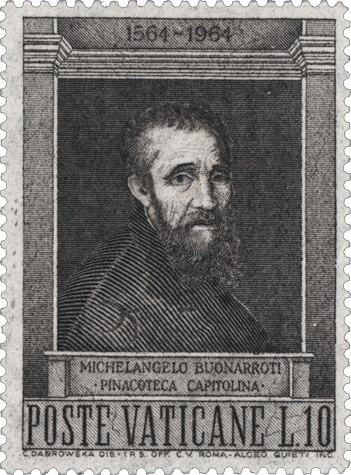
Augustus
Vatican City, Scott #1683
Gaius Octavius (63 BC – 14 AD) was a Roman statesman and military leader who became the first emperor of the Roman Empire in 27 BC. Octavious was born in Rome and raised in Velletri and elected to the College of Pontiffs in 47 BC. The following year, he joined Julius Caesar in Hispania. He was named as heir and prime beneficiary of Caesar's will. Afterwards, Octavius took the name Gaius Julius Caesar and was called Octavian. After Caesar's assassination, he assembled an army, returned to Rome, and defeated Mark Antony in Cisalpine Gaul. He, Mark Antony, and Marcus Lepidus formed the Second Triumvirate in 43 BC. They defeated Caesar's assassins at the Battle of Philippi. Octavian divorced Clodia Pulchra, claiming the marriage was never consummated. He married Scribonia, then after little more than a year, divorced her to marry Livia Drusilla. Lepidus was ejected from the Triumvirate, and Octavian defeated Antony and Cleopatra in the Battle of Actium in 30 BC. In 27 BC, the Senate proclaimed him Augustus, and by 23 BC, he was effectively emperor. According to Mark Antony, Augustus was sexually available to Julius Caesar in Hispania. Augustus prostituted himself to Aulus Hirtius in Hispania for gold, and his constant companion was Marcus Vipsanius Agrippa.
